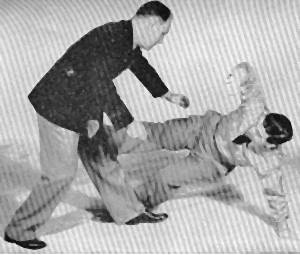
Editor’s note: Section VII, "Taking Prisoners" and Section VIII, "Defenses against Knife and Sword," are omitted. Figure 47-2, showing a "defense against wary approach with knife," shows why – many of these techniques work better in demonstrations than in practice.

In Section IX, be aware that the photos show the unarmed Defender dangerously far away from the armed Attacker. Also, to do the unarmed defenses shown, Defender must practice covering ranges of 1-2 meters very rapidly without much telegraph.
56. DEFENSE AGAINST DOWNWARD BLOW WITH CLUB. --
As your opponent strikes a downward blow with the club, you will present your left forearm against his right forearm in the manner illustrated in Figure 51-1.
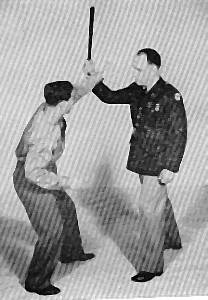
Figure 51-1.
You will make no attempt to stop the blow directly, but rather deflect it to your left so as to enable you to wrap your left arm around his right one, bringing your wrist under his right elbow. See Figure 51-2.
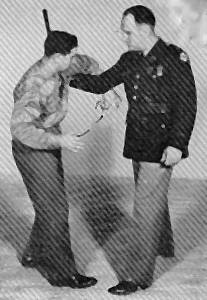
Figure 51-2.
[Technical comments: In Figure 51-2, Defender might want to join hands and then use the right to raise the left, as this is stronger, faster, and harder to escape]
Your further action is to place your right hand on your opponent’s shoulder or upper arm and lock your left hand on your own forearm. See Figure 51-3.
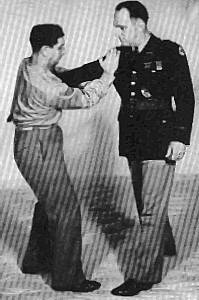
Figure 51-3.
You are now in a position to break your opponent’s arm simply by applying pressure. A small degree of pressure will cause him to drop his weapon.
[Technical comments: A bent arm is stronger and faster, and therefore better, than the straight arm shown in Figure 51-3.]
57. DEFENSE AGAINST SIDE STROKE WITH CLUB. –
The more experienced individual will strike a slanting sideward blow at the side of the head as illustrated in Figure 52-1.
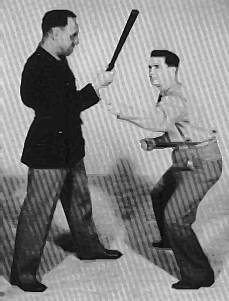
Figure 52-1.
You will make no attempt to stop the blow, but will lower your head out of range by bending the knees, at the same time reaching upward with your left hand or arm, without grasping your opponent’s club arm) and striking your opponent’s forearm, continuing its momentum over your head. See Figure 52-2. [Technical comments: Note – bend the knees, do not lean back. This requires practice.]
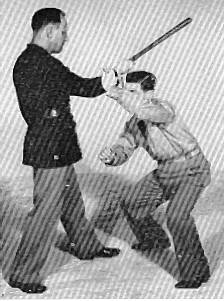
Figure 52-2.
This will turn your opponent completely off balance. You will now take a long step with your right leg to your opponent’s right, at the same time twisting your body to left and raising your right arm shoulder-high with the back of your body and shoulders. Your elbow will make contact in the soft spot of your opponent’s side between the hipbone and the short ribs. See figure 52-3.
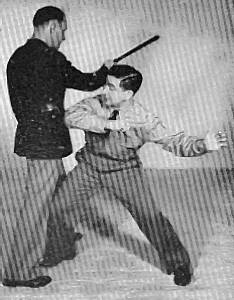
Figure 52-3.
A man struck in this manner will drop as though shot. [Technical
comments: Although a nice evasion, Defender should keep his left hand up
to protect his head from Attacker’s elbow. A more upright posture would
also deliver more of Defender’s weight into his attack.]
58. HOW TO HOLD CLUB. – The club, when it is carried, should be used only with the left hand. [Technical comment: Presumably left-handed people would use the stick only with the right hand, as the reason for this usage is that it leaves the strong hand free to protect or draw a holstered handgun. But if the stick is the only weapon, then there is no reason to avoid putting it into the strong hand.]
The thong should be of a length suited to the hand of the individual who is to use it. In wrapping the thong around the hand or arm, the following procedure should be followed. The thumb is first hooked through the loop of the thong. See Figure 53-1.
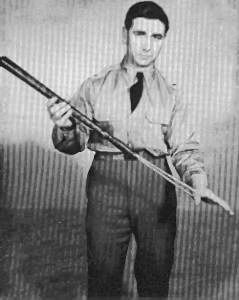
Figure 53-1.
The thong is then brought over the back of the hand (Figure 53-2) and the handle of the club brought up from the little finger edge and then grasped by the hand with the grip illustrated in Figure 53-3.
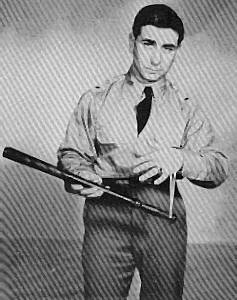
Figure 53-2.
[INSERT FIG 53-3]
Figure 53-3.
The club should not be used as a bludgeon except in dire necessity, but should be used as an extension of the arm. It is a much more effective weapon if it is used to jab rather than to strike. Practice in using the club in this manner will render it very effective against attack by many types of weapon. It can then be used in parrying blows or turning aside thrusts in the same manner as the fencer uses the foil.
When it is necessary to stop a charging opponent or to subdue a recalcitrant individual, a jab to the solar plexus is extremely efficient. See Figure 54-1.
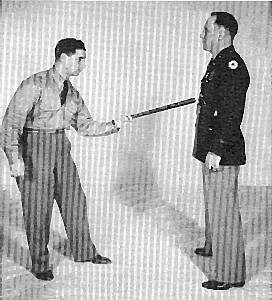
Figure 54-1.
If your opponent is so close as to render the body jab impractical, the chin or throat jab is equally effective. See Figure 54-2.
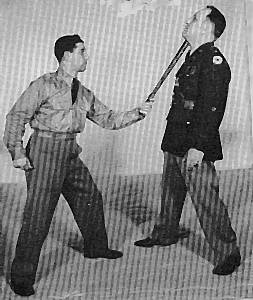
Figure 54-2.
[Technical comments: Strikes to the head and neck represent potentially lethal force and today law enforcement trainers strongly discourage them. Be that as it may, the man with the stick should not bend forward, as shown in 54-1, as this puts him ahead of his center of balance; the stance shown in 54-2 shows better posture. Note the right hand, which is shown in the correct position to protect a holstered handgun. However, without a handgun, the hand would be better used to block and strike.]
59. WHERE TO STRIKE IF NECESSARY. –
If an opponent or opponents are moving in and you do not wish to damage them severely, their desire for combat can often be cooled by the blow to the wrist or hands (Figure 55-1) or by the blow to the shin (Figure 55-2).
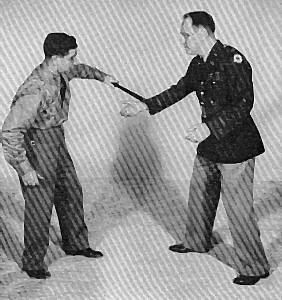
Figure 55-1.

Figure 55-2.
If it becomes necessary to put a dangerous antagonist out of action, the blow to the side of the throat just behind the jaw line (Figure 55-3) is efficient without being dangerous.
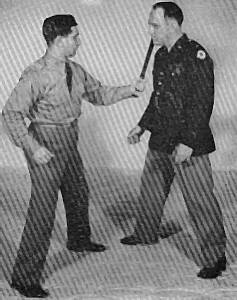
Figure 55-3.
The backhand blow to the opposite side of the throat (Figure 55-4) is equally effective.
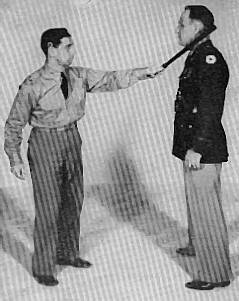
Figure 55-4.
60. USING CLUB AS COME-ALONG. –
The most efficient use of the club is its use as an adjunct in taking a man prisoner without causing him bodily harm. The club is still in the left hand. Your right hand grasps your opponent’s right wrist, and lifting his arm slightly, the club is thrust under his left arm (Figure 56-1), over his shoulder with its end lodged just behind your opponent’s neck (Figure 56-2).
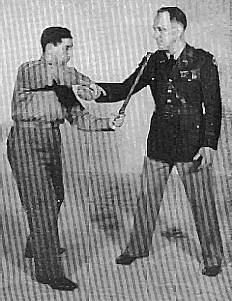
Figure 56-1.
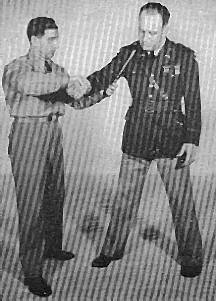
Figure 56-2.
Your hand grasping the hilt of the night stick should be just behind your opponent’s upper arm with your thumb against his ulna nerve two inches above the elbow. Pressure is applied downward and backward with your right hand on your opponent’s right wrist. Your opponent will be forced to his toes by the pain. However, he will be in no danger of having his arm broken. See Figure 56-3.
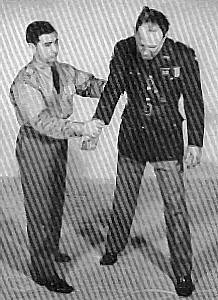
Figure 56-3.
61. USING CLUB AS HANDCUFF. –
You have utilized the standard procedure of searching a prisoner, placing his hands against the wall and causing him to extend his legs as far to the rear as possible. Since he is dangerous, you now wish to secure him in such a manner as to enable you to march him where you will. You will place your right foot just inside of your opponent’s right foot in order to be in position to drop him to the ground if he becomes belligerent, and order him to bring his right wrist backward, at which time you will grasp it with your right hand. See Figure 57-1.

Figure 57-1.
Now place one loop of the thong of your club over his right wrist and bend his right arm at right angles up his back. See Figure 57-2.
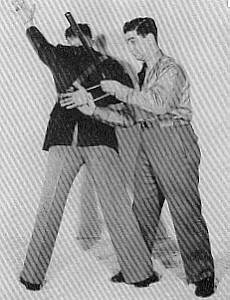
Figure 57-2.
Order him to place the top of his head against the wall and bring his left arm backward. If he fails to obey this order, a slight push on his right arm up his back will change his mind. When he does bring back the left arm, you will insert that hand through the thong also. See Figure 57-3.
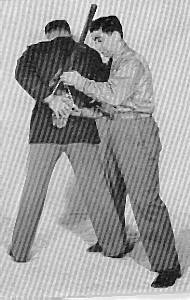
Figure 57-3.
You will now slip the handle of the club as close to your opponent’s body as possible with the long part of the club extending up the back almost to the neck. Grasping the hilt of the club (Figure 57-4), you will be in position to march your prisoner where you will.
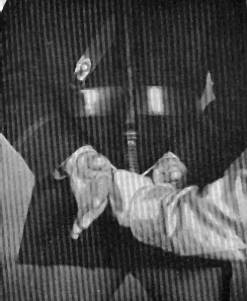
Figure 57-4.
Mike Belzer began practicing Kodenkan (Danzan Ryu) jujutsu at age 9, and in 1974, at age 18, he met and trained with Donn F. Draeger and Takaji Shimizu in Japan. In 1979, after returning to the US from a trip to Malaysia with Draeger, he also began studying Filipino kali under Dan Inosanto. Since 1990 he has focused his training on using "adrenal-stress conditioning" in realistic scenarios against heavily padded assailants. He is presently ranked 5-dan in Kodenkan jujutsu and apprentice instructor in kali, and serves as a consultant to the Los Angeles Police Department's Civilian Martial Arts Advisory Panel (CMAAP).
Joseph Svinth is editor of Journal of Non-lethal Combatives.